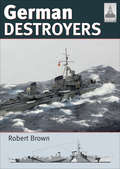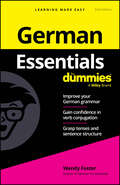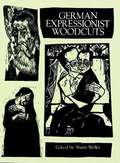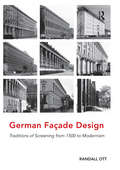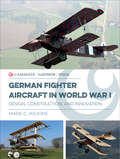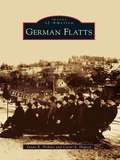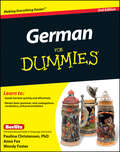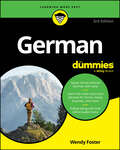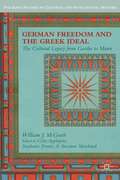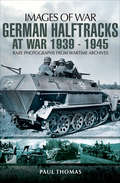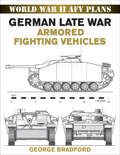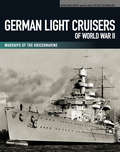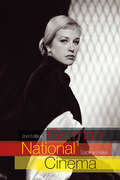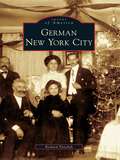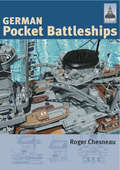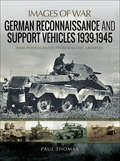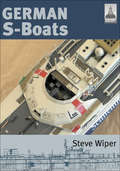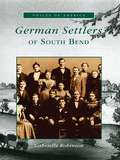- Table View
- List View
German Combat Equipments 1939-45
by Gordon Rottman Ronald VolstadThe field equipment of the German Army in World War II was closely related to that used throughout World War I and earlier, yet it was of relatively light weight, ruggedly constructed, well designed, functional, and generally of a high quality, though this deteriorated in the later war years. A high degree of design standardisation was maintained in most categories of equipment, though materials and their colours often varied widely. There were also many different specialisations for the various arms of service as well as theatres of combat, such as the Afrikakorps in the Western Desert. This title investigates all manner of German combat equipments throughout World War II, from belt buckles to magazine pouches.
German Cultural Studies: An Introduction
by Rob BurnsMajor changes have been taking place in the context of German Studies in both secondary and higher education, with the focus shifting to a broader range of cultural forms. Based on the view that cultures are the products of class, place, gender, and race,German Cultural Studiestakes account of these changes and adopts an interdisciplinary approach in its wide-ranging study of German culture and society since 1871. Emphasizing recent and contemporary developments, the book features chronological sections on Imperial Germany, the Weimar Republic, the Third Reich, the German Democratic Republic, and the Federal Republic. The contributors chart the growth of modernization and the culture industry in Germany, and examine the extent to which culture in any given period functions as an instrument of ideological manipulation or critical enlightenment. Throughout, the emphasis is on the interactions of culture, society and ideology, and the role of culture in both public and private consciousnesses. Copiously illustrated, and with a comprehensive bibliography, the volume will be essential reading for anyone interested in modern and contemporary German society and its culture.
German Culture through Film: An Introduction to German Cinema
by Robert C. Reimer Reinhard Zachau Margit M. SinkaGerman Culture through Film: An Introduction to German Cinema is an English-language text that serves equally well in courses on modern German film, in courses on general film studies, in courses that incorporate film as a way to study culture, and as an engaging resource for scholars, students, and devotees of cinema and film history. In its second edition, German Culture through Film expands on the first edition, providing additional chapters with context for understanding the era in which the featured films were produced. Thirty-three notable German films are arranged in seven chronological chapters, spanning key moments in German film history, from the silent era to the present. Each chapter begins with an introduction that focuses on the history and culture surrounding films of the relevant period. Sections within chapters are each devoted to one particular film, providing film credits, a summary of the story, background information, an evaluation, questions and activities to encourage diverse interpretations, a list of related films, and bibliographical information on the films discussed.
German Destroyers (Shipcraft Ser. #25)
by Robert BrownThis fully illustrated guide to building model ships covers a variety of WWII era German destroyers with info on accessories and kits of various scales. The &‘ShipCraft&’ series provides in-depth information about building and modifying model kits of famous warship types. Lavishly illustrated, each book takes the modeler through a brief history of the subject class, highlighting differences between sister-ships and changes in their appearance over their careers. Paint and camouflage details are shown with color profiles, line drawings, and scale plans. The modeling section reviews the strengths and weaknesses of available kits, lists commercial accessory sets, and provides hints on modifying and improving the basic kit. This is followed by an extensive photographic gallery of high-quality models in a variety of scales. Each volume concludes with a section on research references, including books, monographs, large-scale plans and websites. This volume covers the large and powerful German destroyers of the Second World War era. Always popular as modelling subjects, interest in them has been further increased recently by the release of a number of very fine large-scale kitsThe &‘ShipCraft&’ series provides in-depth information about building and modifying model kits of famous warship types. Lavishly illustrated, each book takes the modeler through a brief history of the subject class, highlighting differences between sister-ships and changes in their appearance over their careers. This includes paint schemes and camouflage, featuring color profiles and highly detailed line drawings and scale plans. The modeling section reviews the strengths and weaknesses of available kits, lists commercial accessory sets for super-detailing of the ships, and provides hints on modifying and improving the basic kit. This is followed by an extensive photographic gallery of selected high-quality models in a variety of scales, and the book concludes with a section on research references – books, monographs, large-scale plans and relevant web sites. This volume covers the large and powerful German destroyers of the Second World War era. Always popular as modeling subjects, interest in them has been further increased recently by the release of a number of very fine large scale kits. With its unparalleled level of visual information – paint schemes, models, line drawings and photographs – this book is simply the best reference for any model maker setting out to build one of these unusual ships.
German Essentials For Dummies
by Wendy FosterAn easy-to-follow and hands-on guide for German learners new to the language and for anyone seeking to brush up on the fundamentals German Essentials For Dummies, 2nd Edition is a quick, concise, and straightforward guide to conversational German. Perfect for anyone who wants to jumpstart their understanding of German, the book is packed with examples, definitions, and handy tips you can start using immediately. This clear guide explains key German concepts you can use to accelerate your progress in a German class, in self-instruction, or as you move through a language-learning app. Inside: Know the foundations of the German language Understand German grammar, sentence structure, pronunciation, and language conventions See German conversation examples and definitions Packed with vocabulary tips, grammar instruction, pronunciation techniques, and more, German Essentials For Dummies, 2nd Edition is a can't-miss guide for German learners, German students, and language app users looking for a learning boost.
German Expressionist Woodcuts
by Shane WellerGerman Expressionism was an extraordinarily vivid presence in the art of the early twentieth century, its violent colors and often distorted, stylized forms reflecting not only the rebellious spirit of its participants, but the revolutionary mood of the new century itself. One of the most popular media used by the German Expressionists was the woodcut, important in the history of German art from the time of Albrecht Dürer (1471-1528), and especially suited to Expressionism's bold graphics.This superb collection presents over 100 finely reproduced woodcuts from the work of nearly 30 major artists in the movement who worked in the woodcut medium. Among them are Ernst Barlach, Max Beckmann, Lyonel Feininger, Ernst Ludwig Kirchner, Käthe Kollwitz, Franz Marc, Emil Nolde, Max Pechstein, and many others. Most of the woodcuts reproduced here date from the first three decades of the twentieth century. They are powerful works, ranging in mood from Felix Müller's pensive portrait of Carl Sternheim (1925) to Franz Marc's electric Riding School (1913) and Ernst Barlach's profoundly moving Christ on the Mount of Olives (1920).Readers interested in the art of the woodcut as well as students and enthusiasts of twentieth-century art will find this volume ideal for browsing and study. Individual captions for each selection, notes on each artist, and an informative introduction to the art of the woodcut and the German Expressionist movement add to the book's value as a reference work.
German Façade Design: Traditions of Screening from 1500 to Modernism
by Randall OttGerman architecture prior to the modern period has received less systemic, analytical study than that of Italy, France, and Britain. Scholarly discussion of broad traditions or continuities within Germanic or Central European façade design is even sparser. Baroque era studies of the region mostly devote themselves to isolated architects, monuments, or movements. Modernism's advent decisively changed this: Germanic architecture enjoyed sudden ascendancy. Yet, even so, study specifically of that region's façades still lagged – nothing compares to the dozens of treatments of Le Corbusier's façade systems, for example, and how these juxtapose with French neoclassical or Italian Renaissance methods. Given the paucity of multi-period studies, one can be forgiven for believing Germany's effervescence of radical, modern works seems unprecedented. This book takes up these multiple quandaries. It identifies and documents a previously unrecognized compositional tradition - characterized here as the 'screen façade' – and posits it as a counter-narrative critiquing the essentialist, 'authentic' canon currently dominant in Western architectural history. By crossing evenly over the dividing line between the historical and modern periods, it offers valuable insights on indigenous roots underlying some aspects of Germany's invigorating early twentieth-century architectural developments. The book chronologically examines 400 years of closely related facades, concentrated in Germany but also found in Austria, the Czech Republic, German-speaking Switzerland, and nearby areas of Central Europe. While nearly 75 buildings are mentioned and illustrated, a dozen are given extensive analysis and the book focuses on the works of three architects – Schinkel, Behrens and Mies. Relationships between examples of these three architects' façades far transcend mere homage amongst masters. Glimmers of the system they eventually codify are apparent as early as at Heidelberg Castle in 1559 and Nürnberg's Rathaus in 1622. The book argues that in Germany, northern Gothic affinities for bisection, intense repetition and rote aggregation intersected with southern Classical affinities for symmetry, hierarchy and centrality, thereby spawning a unique hybrid product – the screen. Instead of graphic formality, this study is guided by on-site perceptions, propositional contrasts, means of approach, interpretive conflicts and emotion and it relates the design of these façades to concepts proposed by contemporary philosophers including Novalis, Hegel, Nietzsche, Freud, Adorno, and, most importantly, Gadamer on hermeneutics.
German Façade Design: Traditions of Screening from 1500 to Modernism
by Randall OttGerman architecture prior to the modern period has received less systemic, analytical study than that of Italy, France, and Britain. Scholarly discussion of broad traditions or continuities within Germanic or Central European façade design is even sparser. Baroque era studies of the region mostly devote themselves to isolated architects, monuments, or movements. Modernism's advent decisively changed this: Germanic architecture enjoyed sudden ascendancy. Yet, even so, study specifically of that region's façades still lagged – nothing compares to the dozens of treatments of Le Corbusier's façade systems, for example, and how these juxtapose with French neoclassical or Italian Renaissance methods. Given the paucity of multi-period studies, one can be forgiven for believing Germany's effervescence of radical, modern works seems unprecedented. This book takes up these multiple quandaries. It identifies and documents a previously unrecognized compositional tradition - characterized here as the 'screen façade' – and posits it as a counter-narrative critiquing the essentialist, 'authentic' canon currently dominant in Western architectural history. By crossing evenly over the dividing line between the historical and modern periods, it offers valuable insights on indigenous roots underlying some aspects of Germany's invigorating early twentieth-century architectural developments. The book chronologically examines 400 years of closely related facades, concentrated in Germany but also found in Austria, the Czech Republic, German-speaking Switzerland, and nearby areas of Central Europe. While nearly 75 buildings are mentioned and illustrated, a dozen are given extensive analysis and the book focuses on the works of three architects – Schinkel, Behrens and Mies. Relationships between examples of these three architects' façades far transcend mere homage amongst masters. Glimmers of the system they eventually codify are apparent as early as at Heidelberg Castle in 1559 and Nürnberg's Rathaus in 1622. The book argues that in Germany, northern Gothic affinities for bisection, intense repetition and rote aggregation intersected with southern Classical affinities for symmetry, hierarchy and centrality, thereby spawning a unique hybrid product – the screen. Instead of graphic formality, this study is guided by on-site perceptions, propositional contrasts, means of approach, interpretive conflicts and emotion and it relates the design of these façades to concepts proposed by contemporary philosophers including Novalis, Hegel, Nietzsche, Freud, Adorno, and, most importantly, Gadamer on hermeneutics.
German Fighter Aircraft in World War I: Design, Construction and Innovation (Casemate Illustrated Special #Ciss0002)
by Mark C. WilkinsThis fully illustrated volume explores German military aviation during WWI through archival photographs and authentically detailed replicas. Fighter aircraft were developed during World War I at an unprecedented rate, as nascent air forces sought to achieve and maintain air supremacy. German manufacturers innovated at top speed, while constantly scrutinizing the development of new enemy aircraft. The Germans also utilized the concept of modular engineering, which allowed them to disassembled or reassembled their aircraft quickly in the field. The pinnacle of their aeronautical innovations was the iconic Fokker D VII—the only aircraft specifically mentioned in the Treaty of Versailles, which forbade Germany from building it after the war. German Fighter Aircraft in World War I explores how German fighter aircraft were developed during the war, the advancements and trials that made the Fokker D VII possible, and the different makes and types of aircraft. Using unpublished images including photographs of surviving aircraft, archive images, and models and replicas, this volume shows details of aircraft that were kept top secret during the war. Extensively illustrated with 140 photos and ten color profiles, this is will be essential reading for all WWI aviation enthusiasts and modelers.
German Film after Germany: Toward a Transnational Aesthetic
by Randall HalleWhat is the work of film in the age of transnational production? To answer that question, Randall Halle focuses on the film industry of Germany, one of Europe's largest film markets and one of the world's largest film-producing nations. In the 1990s Germany experienced an extreme transition from a state-subsidized mode of film production that was free of anxious concerns about profit and audience entertainment to a mode dominated by private interest and big capital. At the same time, the European Union began actively drawing together the national markets of Germany and other European nations, sublating their individual significances into a synergistic whole. This book studies these changes broadly, but also focuses on the transformations in their particular national context. It balances film politics and film aesthetics, tracing transformations in financing along with analyses of particular films to describe the effects on the film object itself. Halle concludes that we witness currently the emergence of a new transnational aesthetic, a fundamental shift in cultural production with ramifications for communal identifications, state cohesion, and national economies.
German Flatts
by Caryl A. Hopson Susan R. PerkinsGerman Flatts was established on March 7, 1788, and is comprised of two unique villages. The village of Mohawk was incorporated in 1844, and Ilion soon followed in 1852. With their proximity to the Erie Canal, these villages saw their share of business and industry and flourished as communities. Mohawk was home to a number of famous people, including a treasurer of the United States, a General Motors industrialist, one of the fated space shuttle Challenger crew members, and the two Keno brothers who made antiques a popular obsession on the television program Antiques Roadshow. Ilion is the birthplace of the Remington Arms Company, one of Herkimer County's oldest industries that still exists today and is known around the world. German Flatts provides an interesting snapshot of the daily life and important events in this community's fascinating history.
German For Dummies
by Paulina Christensen Anne Fox Wendy FosterThe fun and easy way to learn the fascinating language of German with integrated audio clips! German For Dummies, Enhanced Edition uses the renowned Berlitz approach to get you up and running with the language-and having fun too! Designed for the total beginner, this guide introduces you to basic grammar and then speedily has you making conversation. Integrated audio clips let you listen and learn as you hear pronunciations and real-life conversations. Fun and games sections ease your way into German fluency, phonetic spellings following expressions and vocabulary improve your pronunciation, and helpful boxes and sidebars cover cultural quirks and factoids. Master the nuts and bolts of German grammar Learn phrases that make you sound German-and know what never to say in German Whether you're just looking for a greeting besides "Guten tag" or you want to become a foreign exchange student, this enhanced edition of German For Dummies gives you what you need to learn the language-as much as you like, as fast as you like!
German For Dummies
by Wendy FosterIt's easy to speak and understand German with the Dummies language method German For Dummies is a clear and easy introduction to German that speeds up the process of speaking the language. The trusted Dummies language learning method is quick and practical, so you'll know what to say and do when traveling to a German-speaking country or interacting with German speakers in your community. You'll learn the basics of German grammar and pronunciation, and then you'll explore common phrases you'll need in everyday situations. Get ready to study, work, or travel abroad—integrate German into your everyday life. This essential resource helps you make small talk, understand common expressions, navigate business settings, ask for directions, go to the doctor, and beyond Learn how German works—grammar, pronunciation, and important constructions Build your vocabulary with an updated mini-dictionary and learn common expressions you'll hear while abroad Brush up your conversation skills with authentic dialogues, plus follow along with online audio Get practice reading, writing, and speaking German, so you're ready to communicate effectively With German For Dummies, students, travelers, and business professionals can gain the confidence to converse in German.
German Freedom And The Greek Ideal
by William J. McgrathThis book traces this German idea of freedom from the late Enlightenment through the early twentieth century. McGrath shows how German intellectual and artists invoked the ancient Greeks in order to inspire Germans to cultural renewal and to enrich their understanding of freedom as something deeper and more urgent that political life could offer.
German Halftracks at War, 1939–1945 (Images of War)
by Paul ThomasThe author of the bestselling Panzer IV at War delivers a highly illustrated look at &“a key element in the German Blitzkrieg&” during the Second World War (HistoryOfWar.org). In the aftermath of the Great War, which saw the introduction of the tank, the more far sighted military leaders realized that the future of warfare hinged on a balance of mobility, firepower and protection. Tanks would need to be accompanied into battle by supporting arms, specifically infantry, artillery and engineers. An all fully-tracked field army was thought to be too expensive, so the semi-tracked support vehicle (commonly called a halftrack) was born. The halftrack concept was embraced by France, the US and most notably Germany. The Germans commissioned numerous types of half-tracked tractors, which were classified by the weight of their towed load. These vehicles were designated Sonderkraffarzeug (special motorized vehicle), abbreviated as Sd.Kfz. These front-wheel steering vehicles with tracked drive transformed the fighting quality of the armored divisions. They carried the infantry alongside the advancing panzers and brought guns and pontoon-bridge sections. The halftrack also became the preferred reconnaissance vehicle. This latest addition to the highly successful and collectable Images of War series has a superb collection of rare images, supported by detailed captions and text, of the many Sd.Kfz variants in diverse theatres of war. It is worth reflecting that, without half-tracks, there could have been no Blitzkrieg.
German Late War Armored Fighting Vehicles: World War II AFV Plans (AFV Plans)
by George BradfordFor modelers and WWIl enthusiasts, a collection of scale drawings of German combat vehicles. For armor modeling and military vehicle enthusiasts, this volume is filled with fine-scale drawings of Germany&’s late war armored vehicles including: • Pz. Kpfw. V Panther Tank • Pz. Kpfw. VI Tiger I and II • Pz. Jager Elephant Tank Destroyer • Sd.Kfz. 234/2 &“Puma&” Armored Car • Jagdtiger with Henschel suspension • And dozens more . . .
German Light Cruisers of World War II: Warships of the Kriegsmarine (Warships Of The Kriegsmarine Ser.)
by Gerhard Koop Klaus-Peter Schmolke&“An immensely interesting look&” at the Emden, Königsberg, Karlsruhe, Köln, Leipzig, and Nürnbergships &“from drawing board to destiny&” (War History Online). The warships of the World War II era German Navy are among the most popular subject in naval history with an almost uncountable number of books devoted to them. However, for a concise but authoritative summary of the design history and careers of the major surface ships it is difficult to beat a series of six volumes written by Gerhard Koop and illustrated by Klaus-Peter Schmolke. Each contains an account of the development of a particular class, a detailed description of the ships, with full technical details, and an outline of their service, heavily illustrated with plans, battle maps and a substantial collection of photographs. These have been out of print for ten years or more and are now much sought after by enthusiasts and collectors, so this new modestly priced reprint of the series will be widely welcomed. This volume is devoted to the six ships from Emden to Nürnberg that were built between the wars. They were primarily intended for commerce-raiding, but the war gave them few opportunities for such employment, although they did provide useful support for key naval operations in the Baltic and North Sea. Two were lost in the 1940 Norway campaign, but the remainder survived for most of the conflict. &“A ship-by-ship history of the cruisers. The text is supported by an excellent collection of plans and photographs. Overall this is a very impressive history of a fairly unimpressive set of warships.&”—HistoryOfWar.org
German National Cinema (National Cinemas)
by Sabine HakeGerman National Cinema is the first comprehensive history of German film from its origins to the present. In this new edition, Sabine Hake discusses film-making in economic, political, social, and cultural terms, and considers the contribution of Germany's most popular films to changing definitions of genre, authorship, and film form. The book traces the central role of cinema in the nation’s turbulent history from the Wilhelmine Empire to the Berlin Republic, with special attention paid to the competing demands of film as art, entertainment, and propaganda. Hake also explores the centrality of genre films and the star system to the development of a filmic imaginary. This fully revised and updated new edition will be required reading for everyone interested in German film and the history of modern Germany.
German Naval Camouflage, 1942–1945: 1942 - 1945
by John Asmussen Eric LeonSecond in &“the most complete and authoritative set of books ever written on the color schemes used by the Kriegsmarine throughout World War II&” (Great Models). This book completes a highly original and superbly illustrated two-volume survey of German naval camouflage and markings in the Nazi era. On first publication in 2012, the 1939-1941 volume was quickly recognized by warship enthusiasts and modelmakers as a major step forward in the understanding of a complex and much debated topic. It is already considered the standard reference, and this second volume is keenly awaited. Although a few crucial documents have recently come to light, this study is largely based on close scrutiny of all available photos, including many newly discovered, collated with the first-hand testimony of Kriegsmarine survivors. After decades of study, the authors are probably the world&’s leading experts, and their work challenges many accepted views, while greatly expanding the general understanding of the subject. The fruits of their labors are presented in the form of exquisite color illustrations of every scheme and variation for which evidence is available. This volume covers all major surviving ships down to destroyers from 1942 to the end of the war, and adds a new section on torpedo boats. While there can never be a last word on such an elusive and poorly documented subject, these two volumes will remain the most authoritative work in the field for many years to come.&“Impressive, wonderful and indispensable for both historians and modelers or naval wargamers.&” —Miniaturas JM
German New York City (Images of America)
by Richard PanchykGerman New York City celebrates the rich cultural heritage of the hundreds of thousands of German immigrants who left the poverty and turmoil of 19th- and 20th-century Europe for the promise of a better life in the bustling American metropolis. German immigration to New York peaked during the 1850s and again during the 1880s, and by the end of the 19th century New York had the third-largest German-born population of any city worldwide. German immigrants established their new community in a downtown Manhattan neighborhood that became known as Kleindeutschland or Little Germany. During the late 19th and early 20th centuries, much of the German population moved north to the Upper East Side's Yorkville and subsequently spread out to the other boroughs of the city.
German Pittsburgh (Images of America)
by Michael R. ShaughnessyGerman Pittsburgh explores the multifaceted cultural history of German-speaking immigrants and residents in the Greater Pittsburgh area. Today over one quarter of the city's residents claim German heritage, the largest ethnic group in the region. German-speaking Pittsburghers include names like H. J. Heinz, Honus Wagner, and the Kaufmanns, and they produced beloved Pittsburgh beers such as Iron City and Penn Pilsner. It might be surprising to know that German was an official language of the city at one time, and a daily German newspaper was printed from the mid-1800s up through World War II. Today remnants of the German-speaking community can be found on the North Side, the South Side, Troy Hill, and Mount Oliver, to name a few. German Pittsburgh provides an overview of the contributions that this diverse ethnic community has made and is making today in the city.
German Pocket Battleships (ShipCraft #Vol. 1)
by Roger ChesneauEverything the ship modeller needs to know about building a famous warship Numerous detailed plans and colour illustrations Focuses on very popular modelling subjects which are represented by a wide selection of kits The 'ShipCraft' series provides in-depth information about building and modifying model kits of famous warship types. Lavishly illustrated, each book takes the modeller through a brief history of the subject class, using scale plans to highlight differences between sisterships and changes in their appearance over their careers, then moves to an extensive photographic survey of either a high-quality model or a surviving example of the ship. Hints on building the model, and on modifying and improving the basic kit, are followed by a section on paint schemes and camouflage, featuring numerous colour profiles and highly-detailed line drawings. The strengths and weaknesses of available kits of the ships are reviewed, and the book concludes with a section on research references—books, monographs, large-scale plans and relevant websites. For the first volume in this series, the author has chosen the German 'pocket battleships' of WW2, the best-known of which was the Graf Spee of Battle of the River Plate fame. This innovative and infamous class of surface raiders has long been a popular subject for ship modellers, many manufacturers producing kits of the Graf Spee and the rather different Admiral Scheer and Ltzow. This book will show ship modellers how to turn their kits into something really special, but its unparalleled level of visual information will also appeal to the more general warship enthusiast. Roger Chesneau is a lifelong ship modeller and author of numerous naval books, including Ship Models in Plastic.
German Reconnaissance and Support Vehicles, 1939–1945 (Images of War)
by Paul ThomasThis WWII pictorial history illustrates the full range of Nazi vehicles used in reconnaissance and support missions throughout the war. The German military used reconnaissance and support vehicles widely in the Second World War. This book illustrates the full range of these vehicles with authoritative information and more than 200 rare wartime photographs. Both tracked and wheeled vehicles were employed for reconnaissance and screening. These included light tanks such as the Panzer I and Panzer II, armored cars such as the six- and eight- wheeled Schwerer Panzerspähwagen, and motorcycles such as the famous BMW R75 or the Zundapp KS750. In addition to their recon role they would, on occasion, engage similar light units. Support vehicles such as the tracked Sd.Kfz.2 Kettenkrad, and the renowned Sd.Kfz.251 halftracks were used in the follow-up role, frequently with mounted grenadiers to mop up over-run enemy positions.
German S-Boats (ShipCraft)
by Steve WiperThe 'ShipCraft' series provides in-depth information about building and modifying model kits of famous warship types. Lavishly illustrated, each book takes the modeller through a brief history of the subject class, highlighting differences between sister-ships and changes in their appearance over their careers. This includes paint schemes and camouflage, featuring colour profiles and highly-detailed line drawings and scale plans. The modelling section reviews the strengths and weaknesses of available kits, lists commercial accessory sets for super-detailing of the ships, and provides hints on modifying and improving the basic kit. This is followed by an extensive photographic gallery of selected high-quality models in a variety of scales, and the book concludes with a section on research references—books, monographs, large-scale plans and relevant websites. The subject of this volume is the Second World War German Navy's motor torpedo boats called Schnellboote, known to the Allies as E-Boats. One of the most effective coastal attack craft of the time, the type was built in large numbers and constantly improved as the war progressed, giving many variants to interest modellers. With its unparalleled level of visual information—paint schemes, models, line drawings and photographs—it is simply the best reference for any modelmaker setting out to build one of these famous boats.
German Settlers of South Bend
by Gabrielle RobinsonThe story of the first German immigrants to northern Indiana is the story of the beginnings of South Bend. The predominant immigrant group from the 1840s to the 1870s, the Germans helped build South Bend from an isolated trading post into a thriving industrial city. They also played a key role in transforming the surrounding wilderness into rich and fertile farmland.Using first-hand personal accounts and public documents, German Settlers of South Bend illustrates the lives of these pioneer immigrants and their growing city. The material has been collected from a large number of sources on both sides of the Atlantic, including more than 200 German letters from the 1840s to the 1870s that provide glimpses into the day-to-day lives of these early settlers and their families back in Germany. Descendants of immigrants from all over the United States and Germany have come forward with genealogies, stories, and pictures, providing a far-reaching portrait of the times.



